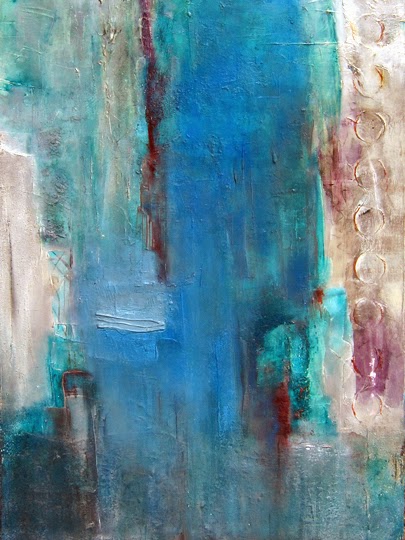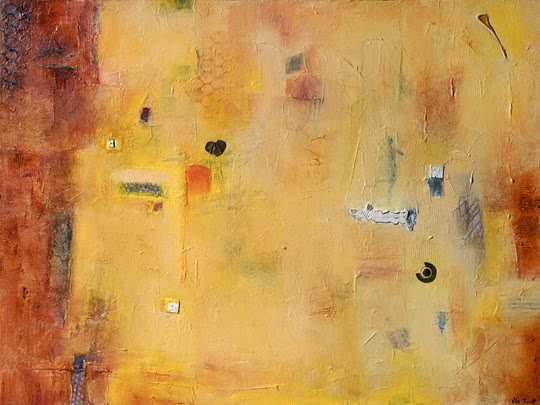Every artist has his or her visual language – sometimes it’s figurative, sometimes it’s not. I must confess, I’ve been avoiding this blog topic for quite a while. You see, I enjoy looking at most abstract art, but as a figurative painter, I find it hard to comprehend how it’s done.
One way to find out is to talk to some abstract artists! I made some calls, and our conversations were quite interesting. My take-away from talking to these three people is that abstract art is fun to make…but it still intimidates me!
 |
| Zuni Pueblo by Jack Roberts, acrylic on canvas 50 x 70 inches |
Jack Roberts is an accomplished, mature artist who has been creating abstract paintings for quite some time. He strives to create a visual sensation, rather than a pictorial reference. “Abstract art is not derivative of representational painting,” he said. “It’s something all itself.
“When I paint, it’s more about the paint and the composition. I like pushing color and shape buttons to stir the viewer’s visual emotions,” he explained.
 |
| Honaki by Jack Roberts, acrylic on canvas 50 x 70 inches |
Jack works on a large canvas, on a flat surface. He says he likes to paint wet-on-wet, so the paint is always moving. He uses many different implements, from plastic spatulas to push brooms and house paint brushes. A garden hose is used to remove paint in some areas, and reveal other dry paint underneath, to create the layers he wants.
 |
| Sandia Peak I by Jack Roberts acrylic on canvas, 50 x 50 inches |
Although Jack’s paintings are not referential, he does admit to being inspired by the many places he visits, from tropical islands to the landscapes of New Mexico and his hometown of Sedona. He also thinks back to personal experiences, and his perceptions of them, rather than the actual events. “Honanki” and “Sandia Peak 1” both speak to me of the Southwest.
Ryan Hale said his influences are the large color-field abstracts of Barnett Newman and Mark Rothko. But his unique body of work reflects his interest in how man-made materials and natural forms interact with each other. Some of his abstract paintings refer to aerial views of cities where these two elements co-exist. Sometimes, they work well together; and, as we know, at other times they clash. His painting entitled “Through the City” presents us with this conundrum.
 |
 |
| Through the City by Ryan Hale, acrylic on canvas 60 x 48 inches |
Forces of Nature by Ryan Hale acrylic on canvas 60 x 48 inches |
After speaking with Ryan, I believe his artistic process is an introspective one. He can see a space where layers of old posters have been torn off and just remnants remain, take that mental reference and use it for a painting. He explains that “the textures and surfaces of a city wall after years of weather, repainting and painting over graffiti or various forms of damage, all stacked and layered through the filter of time, can be quite beautiful.”
 |
| The Forming Earth by Ryan Hale acrylic on canvas, 36 x 36 inches |
Ryan said he works on several pieces at once. He’ll have general ideas for a painting, but they often change, especially since he works very fast, to convey movement and energy. I think you can feel this energy in “The Forces of Nature.” Then, he’ll stop and think about the piece for a while before he changes or adds things. He said that he generally starts with darker hues, and then builds up to lighter ones, looking to see how the colors are flowing and working with each other.
 |
| Here and There by Ava Young, mixed media on canvas, 40 x 30 inches |
Ava brings her interest in collage to her paintings. She works intuitively; starting with a base of molding paste mixed with such materials as dry wall powder or sand to create a ground of texture. Then, she adds other materials. “Here and There” was made with paper, sand, glass beads and metal wire. She paints first with acrylics, and adds a layer of oil paint to give a translucent finish.
 |
| Dancing Away by Ava Young mixed media on canvas, 30 x 40 inches |
Spontaneity, energy, emotions and a lack of boundaries seem to be at the heart of abstract painting. I think that’s why so many artists are drawn to this style of visual language.
Could I? Stay tuned!
View more art by Jack Roberts, Ryan Hale and Ava Young at Wilde Meyer Gallery.
